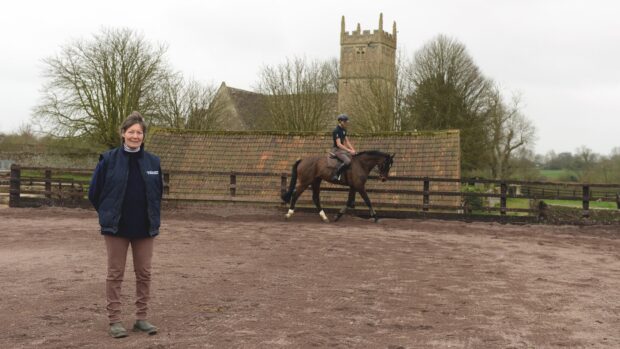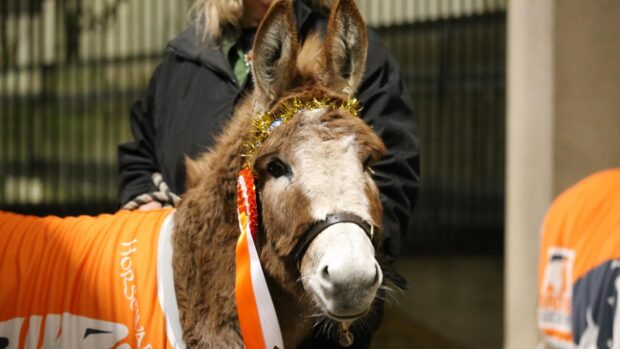Eventing legend Jane Holderness-Roddam has called on the equestrian world to promote and remember balance and feel as the lynchpins of good riding.
The two-time Badminton winner said that while times have changed, with health and safety creating all manner of challenges for instructors, the industry must remember that helping riders develop balance and feel are crucial for safe riding.
“We do have to be careful and we have to think much more so than we used to,” she said, admitting that “health and safety” is one of the biggest barriers to helping people learn to ride well.
“Where do we draw the line?” said Mrs Holderness-Roddam. “I think we have to think about what we, as riders, trainers and people that have influence in the horse world, do about it.
“The independent seat and balance is so important, so the hand at the end of the reins can be the last resort, simply there to collect and balance your horse very lightly, but not to be the be-all and end-all.”
She added that riding bareback as a child, taking on jumping lanes blindfolded and enjoying hacking across all sorts of terrain were part of how she developed feel and balance.
Mrs Holderness-Roddam, who was speaking at the Worshipful Company of Loriners’ conference at Cheltenham racecourse on 6 November, said these are skills that cannot be directly taught, but that instructors can give guidance and exercises to help their pupils develop it for themselves.
“To me an independent seat means an independence from the reins, that you are not pulling on the reins and are in the right place for specific disciplines,” she explained.
“It is also adapting your position to suit physiological movements of your horse. You have to be in balance — that depends very much on your shape. The horse’s size and shape, all of that is an way of affecting balance.
“I think we all need to develop balance by developing feel — that is one of those terms that is very difficult to define, we should feel when we are in the right balance.”
Mrs Holderness-Roddam said movements such as round-the-world — providing someone is holding on to the pony – and exercises such as using an exercise ball, yoga, Pilates and the Alexander technique can all help, especially for those who cannot ride every day.
“Keep getting your children all doing as many things like mounted games, sponsored rides, hunting, all those things that we did when we were young,” she said, adding that with health and safety, insurance and liability at the forefront of people’s minds now, teaching riding is very challenging.
“We do have to be careful and we have to think much more so than we used to,” she said, and ‘health and safety’ is one of the biggest restrictions to getting people riding well,” she said.
“For me the best training is riding out in the country, cantering up and down hills, riding through woods, where you learn those things naturally. You cannot force balance: it has to come naturally.”
Article continues below…
You might also be interested in:

Subscribe to Horse & Hound magazine today – and enjoy unlimited website access all year round

Ask H&H: What is a balance strap?
Since Ulla Salzegeber recommeded using a balance strap during a recent demonstration they have become increasingly popular

Rider fitness: what do we really mean by ‘core’ and how does it work?
Mrs Holderness-Roddam and fellow speaker Mark Smith, who is often referred to as“the bitless man” both agreed more lunge lessons are needed.
“We need to just try and get across to our riders that they really do need to be soft with their hand,” she added.
“Lunge lessons are sadly missing now, we don’t do nearly enough of those. They teach everybody everything about balance and they should be teaching you about feel.”
Mr Smith added: “If all riders spend more time on the lunge, their balance would improve and they wouldn’t be balancing on the horse’s mouth.”
Mr Smith, a former international eventer and founder of the “Bitless Not Brainless” open team chasing squad, works with riders to emphasise correct body-weight position and leg use to avoid them inadvertently giving the horse contradictory signals.
“I have never advocated all riders go bitless — it is all about techniques,” he said, adding he is rather the “soft hands man”.
“It may well be that the competitive riders that ride with a bit would find that a couple of sessions bitless would make them more aware of what they can achieve with their bodies and legs as a focus, rather than their hands.
“Holding your horse cross-country has to be technique in the same way that dressage is.
“There is not a bit in the world that hurts the horse — it is the idiot on the end of the reins.”
Don’t miss next Thursday’s issue of Horse & Hound — out 15 November — for a full report from the conference.



